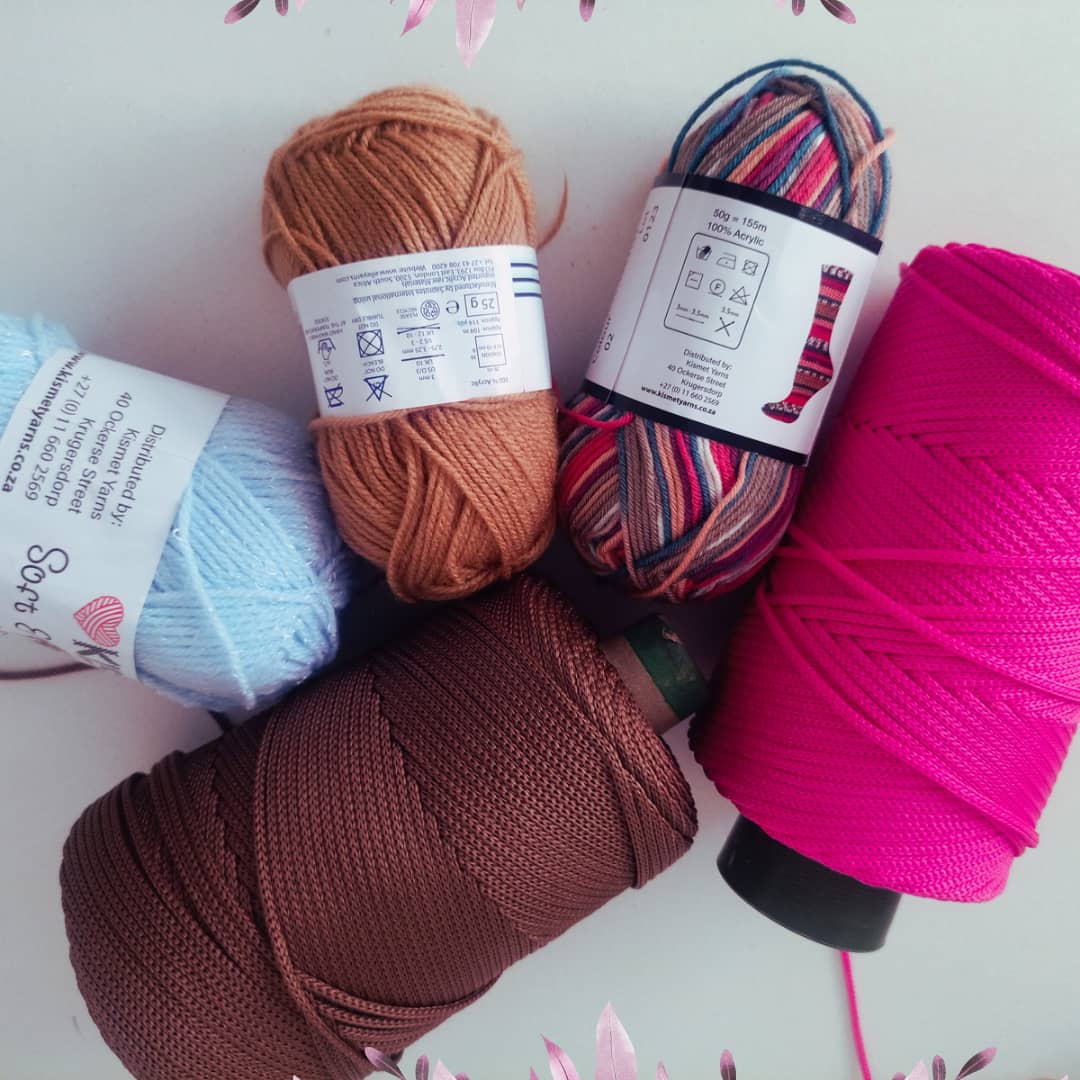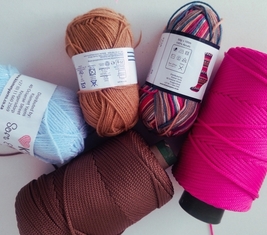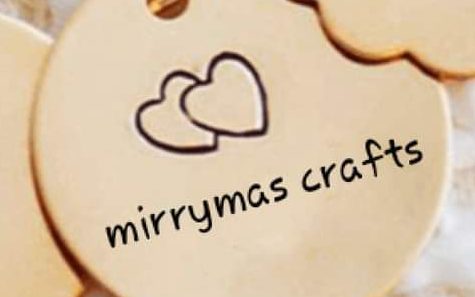
Are you overwhelmed by the array of yarn options for your crochet projects? Fear not! In this beginner’s guide to yarn for crocheting, we’ll break down the essential factors to consider when selecting the right yarn for your next masterpiece.

There are a number of factors you need to consider when choosing yarn for a project and these include color, yarn weight, the type of project and so on. Let’s dive into the world of yarn for crocheting and discover how to choose the ideal yarn for your creations.
1. The type of project
The first thing to consider when choosing yarn for a crochet project is the type of project you’re making. Is it a small project or a big project. A small project may require thin yarn as opposed to a bigger project like a blanket. You also want to ask yourself the use of the project. For example, if you’re making a garment, you’ll want to choose yarn that’s appropriate for clothing, like a soft, washable wool or cotton. For a blanket, you might want to choose a thicker, heavier yarn, like bulky acrylic yarn. The type of project you’re working on will determine the durability needs of your yarn. For things like blankets or scarves, you might prefer a tougher yarn, while delicate lace projects might call for a more delicate yarn. For a crochet bag you might even consider using macrame cord or t shirt yarn, since macrame cord and t shirt yarn are stronger.
2. Understanding Yarn Weight
The next thing to consider is the weight of the yarn. Yarn is typically classified by weight on a scale from 0 (lace weight) to 7 (Jumbo). The weight of the yarn will affect the drape and feel of your finished project, so it’s important to choose a weight that’s appropriate for your project. For example, a light, lacy shawl might be made with a lace or fingering weight yarn, while a thick, cozy blanket might be made with a worsted or bulky weight yarn. Consider how you want your finished project to drape and feel to the touch when choosing the yarn weight. Starting with the lightest weight, the yarn weights are: Lace, superfine, fine, light, medium, bulky, super bulky and jumbo. Lets take a look at each category in brief:
Lace weight yarn.
Lace weight yarn is the lightest weight yarn and is often used for crocheting lace shawls, doilies, and other delicate projects. It is very fine, and usually has a gauge of about 8 to 10 stitches per inch.
Super fine weight yarn
The types of yarn under this category are sock, fingering and baby yarn. This weight yarn is a bit thicker than lace weight yarn, but still quite fine. It is commonly used for socks, shawls, and other lightweight garments.The crochet gauge range is 21 to 32 stitches when you crochet single crochet on a 4 inch long swatch. Recommended crochet hook is from 2.25 mm to 3.5 mm.
Fine weight yarn
The types of yarn under this category are sport and baby. It is often used for projects such as sweaters, hats, and gloves. The crochet gauge range is 16 to 20 stitches when you crochet single crochet on a 4 inch swatch. Recommended crochet hook is from 3.5 mm to 4.5 mm
Light weight yarn
The types of yarn under this category are DK (Double Knit) and Light Worsted. This yarn is often used for projects such as sweaters, scarves, and shawls and has a gauge range of about 12 to 17 stitches per 4 inch swatch. Recommended crochet hook is from 4.5 mm to 5.5 mm.
Medium weight yarn
Worsted, Afghan and Aran are the types of yarn under this category. Medium weight yarn is a popular choice for many projects, such as sweaters, scarves, and hats. It usually has a gauge range of 11 to 14 stitches when you crochet single crochet on a 4 inch long swatch. Recommended crochet hook is from 5.5 mm to 6.5 mm.
Bulky weight yarn
Bulky weight yarn is quite thick and the types of yarn under this category are Chunky, Craft and Rug. The crochet gauge range is 8 to 11 stitches when you crochet single crochet on a 4 inch long swatch. Recommended crochet hook is from 6.5 mm to 9 mm.
Super bulky weight yarn
Super bulky and Roving are the types of yarn under this category and is commonly used for projects such as blankets, sweaters, and other quick projects. It usually has a gauge of about 7 to 9 stitches per 4 inches. Recommended crochet hook is from 9 mm to 15 mm.
Jumbo
This category has the thickest yarn weight and the type of yarn under this category are Jumbo and Roving. The crochet gauge range is 6 stitches and fewer when you crochet single crochet on a 4 inch long swatch. Recommended crochet hook is 15 mm and larger.
The main takeaway is that each weight of yarn has its own unique properties, and is best suited for different types of projects. Now that you know the different weights of yarn, you can choose the right weight for your project!
Before we proceed to the next factor to consider when choosing yarn for your project lets also look at macrame cord. Most of the crochet bags I make are made of macrame. So what do you need to know when choosing macrame cord for a bag?
Macrame cord
Macrame cord is actually not classified as a specific yarn weight. Instead, it is categorized into three types: braided cord, 3 ply rope or single twist string. For crochet bags I mostly prefer braided cord. The cord is measured in thickness, that is from 1mm thick going up.
The thickness of macrame cord is often determined by the size of the project you are working on. For example, a small macrame project like a crochet wallet might use a thinner cord that is 2mm thick, while a larger project like a large tote bag might use a thicker cord like a 4 mm thick macrame cord. There are many different types of macrame cord available, from cotton to synthetic materials.
Cotton macrame cord
Cotton macrame cord is the most common type of cord used. It’s soft and easy to work with, and comes in a variety of thicknesses. It’s also easy to care for, as it can be machine washed and dried. And since cotton is a natural fiber, it’s a good choice for projects where you want a natural look and feel.
Polyester macrame cord
If you’re looking for a synthetic option for your crochet bags, polyester macrame cord is a great choice. Polyester macrame cord is very strong and durable, and it’s also water-resistant, making it a good choice for crochet bags. And since it’s synthetic, it’s less likely to fade over time. However, it’s important to note that very thick polyester macrame cord can be more difficult to crochet with than cotton macrame cord of the same size, that is usually the case for polyester cords thicker than 5mm.
Jute cord
Jute macrame cord is made from the fibers of the jute plant, and it’s a popular choice for projects that require a rustic or natural look. It is strong and durable, and it has a rough, textured feel. Jute is also sensitive to moisture, so it’s not the best choice for projects that will be exposed to water or humidity. But if you’re looking for a natural fiber with a unique look and feel, jute macrame cord is a great option.
3. Fiber Content Matters when choosing yarn for crocheting
The type of fiber content in yarn greatly influences the durability, texture, and care instructions of your crochet project. Popular yarn fibers include wool, cotton, acrylic, and blends of various materials. Wool provides warmth and elasticity, while cotton offers breathability and a crisp texture. Acrylic yarns are known for their affordability and easy-care properties. Choose a fiber that aligns with the intended use of your crochet item.
Cotton – Cotton yarn is a great option. Cotton yarn is durable, soft, and breathable, making it perfect for projects like dishcloths, coasters, and summer garments and even baby wear. It’s also easy to care for, as it can be machine washed and dried. And since cotton is a natural fiber, it’s a great choice for those who have sensitive skin.
Wool – Wool yarn is another popular choice for crochet projects. Wool yarn is known for its warmth, durability, and ability to retain its shape. It’s a great choice for winter garments, like hats and scarves, and for any project where you want a soft and cozy feel. However, it’s important to note that wool can be more difficult to care for than cotton, as it requires hand washing and air drying.
Acylic – Acrylic yarn is a synthetic yarn that is known for its affordability, durability, and easy care. It’s a great choice for beginners, as it’s easy to work with and doesn’t require special care. It’s also less likely to pill or fade over time. And since it’s not a natural fiber, it’s a good choice for those who have allergies or sensitivities to animal fibers.
4. Color Selection for Visual Impact
The color palette you choose can make or break your crochet project. Consider the intended recipient’s preferences and the overall aesthetic you wish to achieve. Bold, vibrant colors can create visual interest and make your project stand out, while neutral tones offer versatility and timeless appeal. Experiment with color combinations to add depth and dimension to your creations.
5.Texture and Style Considerations
Apart from color and fiber content, the texture of the yarn plays a significant role in the appearance of your crochet piece. Smooth yarns highlight stitch definition, making intricate patterns pop, while textured yarns add depth and character to simpler designs. Consider the style you want to achieve – whether it’s classic and elegant or quirky and eclectic – and choose yarn that complements that vision.
6. Budget-Friendly Options
Crocheting can be a budget-friendly hobby if you know where to look for affordable yarn options. Keep an eye out for sales at local craft stores, browse online marketplaces for discounted yarn bundles, or consider upcycling yarn from thrift store finds. Remember, quality yarn doesn’t always have to come with a hefty price tag – with a bit of creativity, you can source budget-friendly yarn for your crochet projects.
Final Thoughts on Yarn for Crocheting
In conclusion, choosing the right yarn for crocheting is all about understanding your project’s needs and your personal preferences. Don’t be afraid to experiment and find what works best for you. Remember, there’s no one-size-fits-all when it comes to yarn for crocheting. It’s all about what feels right in your hands and creates the results you desire.
Experiment with different yarns, colors, and textures to discover what works best for your projects. Happy crocheting!










Can you tell me the brands of yarn you use? I bought some macrame cord and it’s hard on my hands when using it. Your yarn looks softer and easier to use. My 3mm is so thin and hard. Please help me, I love your bags. Thanks
Polyester is hard on the hands and you would need to get used to it. However you can buy cotton macrame cord it is soft and easier. I usually buy on Etsy or Amazon. If your 3mm is so thin you can buy 4mm it will do just fine.